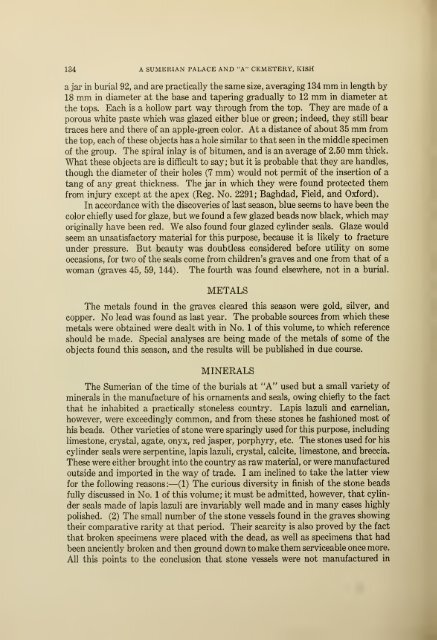A Sumerian Palace and the "A" cemetery at Kish, Mesopotamia
A Sumerian Palace and the "A" cemetery at Kish, Mesopotamia
A Sumerian Palace and the "A" cemetery at Kish, Mesopotamia
You also want an ePaper? Increase the reach of your titles
YUMPU automatically turns print PDFs into web optimized ePapers that Google loves.
134 A SUMERIAN PALACE AND "A" CEMETERY, KISH<br />
a jar in burial 92, <strong>and</strong> are practically <strong>the</strong> same size, averaging 134 mm in length by<br />
18 mm in diameter <strong>at</strong> <strong>the</strong> base <strong>and</strong> tapering gradually to 12 mm in diameter <strong>at</strong><br />
<strong>the</strong> tops. Each is a hollow part way through from <strong>the</strong> top. They are made of a<br />
porous white paste which was glazed ei<strong>the</strong>r blue or green; indeed, <strong>the</strong>y still bear<br />
traces here <strong>and</strong> <strong>the</strong>re of an apple-green color. At a distance of about 35 mm from<br />
<strong>the</strong> top, each of <strong>the</strong>se objects has a hole similar to th<strong>at</strong> seen in <strong>the</strong> middle specimen<br />
of <strong>the</strong> group. The spiral inlay is of bitumen, <strong>and</strong> is an average of 2.50 mm thick.<br />
Wh<strong>at</strong> <strong>the</strong>se objects are is difficult to say; but it is probable th<strong>at</strong> <strong>the</strong>y are h<strong>and</strong>les,<br />
though <strong>the</strong> diameter of <strong>the</strong>ir holes (7 mm) would not permit of <strong>the</strong> insertion of a<br />
tang of any gre<strong>at</strong> thickness. The jar in which <strong>the</strong>y were found protected <strong>the</strong>m<br />
from injury except <strong>at</strong> <strong>the</strong> apex (Reg. No. 2291; Baghdad, Field, <strong>and</strong> Oxford).<br />
In accordance with <strong>the</strong> discoveries of last season, blue seems to have been <strong>the</strong><br />
color chiefly used for glaze, but we found a few glazed beads now black, which may<br />
originally have been red. We also found four glazed cylinder seals. Glaze would<br />
seem an uns<strong>at</strong>isfactory m<strong>at</strong>erial for this purpose, because it is likely to fracture<br />
under pressure. But beauty was doubtless considered before utility on some<br />
occasions, for two of <strong>the</strong> seals come from children's graves <strong>and</strong> one from th<strong>at</strong> of a<br />
woman (graves 45, 59, 144). The fourth was found elsewhere, not in a burial.<br />
METALS<br />
The metals found in <strong>the</strong> graves cleared this season were gold, silver, <strong>and</strong><br />
copper. No lead was found as last year. The probable sources from which <strong>the</strong>se<br />
metals were obtained were dealt with in No. 1 of this volume, to which reference<br />
should be made. Special analyses are being made of <strong>the</strong> metals of some of <strong>the</strong><br />
objects found this season, <strong>and</strong> <strong>the</strong> results will be published in due course.<br />
MINERALS<br />
The <strong>Sumerian</strong> of <strong>the</strong> time of <strong>the</strong> burials <strong>at</strong> "A" used but a small variety of<br />
minerals in <strong>the</strong> manufacture of his ornaments <strong>and</strong> seals, owing chiefly to <strong>the</strong> fact<br />
th<strong>at</strong> he inhabited a practically stoneless country. Lapis lazuli <strong>and</strong> carnelian,<br />
however, were exceedingly common, <strong>and</strong> from <strong>the</strong>se stones he fashioned most of<br />
his beads. O<strong>the</strong>r varieties of stone were sparingly used for this purpose, including<br />
limestone, crystal, ag<strong>at</strong>e, onyx, red jasper, porphyry, etc. The stones used for his<br />
cylinder seals were serpentine, lapis lazuli, crystal, calcite, limestone, <strong>and</strong> breccia.<br />
These were ei<strong>the</strong>r brought into <strong>the</strong> country as raw m<strong>at</strong>erial, or were manufactured<br />
outside <strong>and</strong> imported in <strong>the</strong> way of trade. I am inclined to take <strong>the</strong> l<strong>at</strong>ter view<br />
for <strong>the</strong> following reasons:— (1) The curious divereity in finish of <strong>the</strong> stone beads<br />
fully discussed in No. 1 of this volume; it must be admitted, however, th<strong>at</strong> cylin-<br />
der seals made of lapis lazuli are invariably well made <strong>and</strong> in many cases highly<br />
polished. (2) The small number of <strong>the</strong> stone vessels found in <strong>the</strong> graves showing<br />
<strong>the</strong>ir compar<strong>at</strong>ive rarity <strong>at</strong> th<strong>at</strong> period. Their scarcity is also proved by <strong>the</strong> fact<br />
th<strong>at</strong> broken specimens were placed with <strong>the</strong> dead, as well as specimens th<strong>at</strong> had<br />
been anciently broken <strong>and</strong> <strong>the</strong>n ground down to make <strong>the</strong>m serviceable once more.<br />
All this points to <strong>the</strong> conclusion th<strong>at</strong> stone vessels were not manufactured in

















